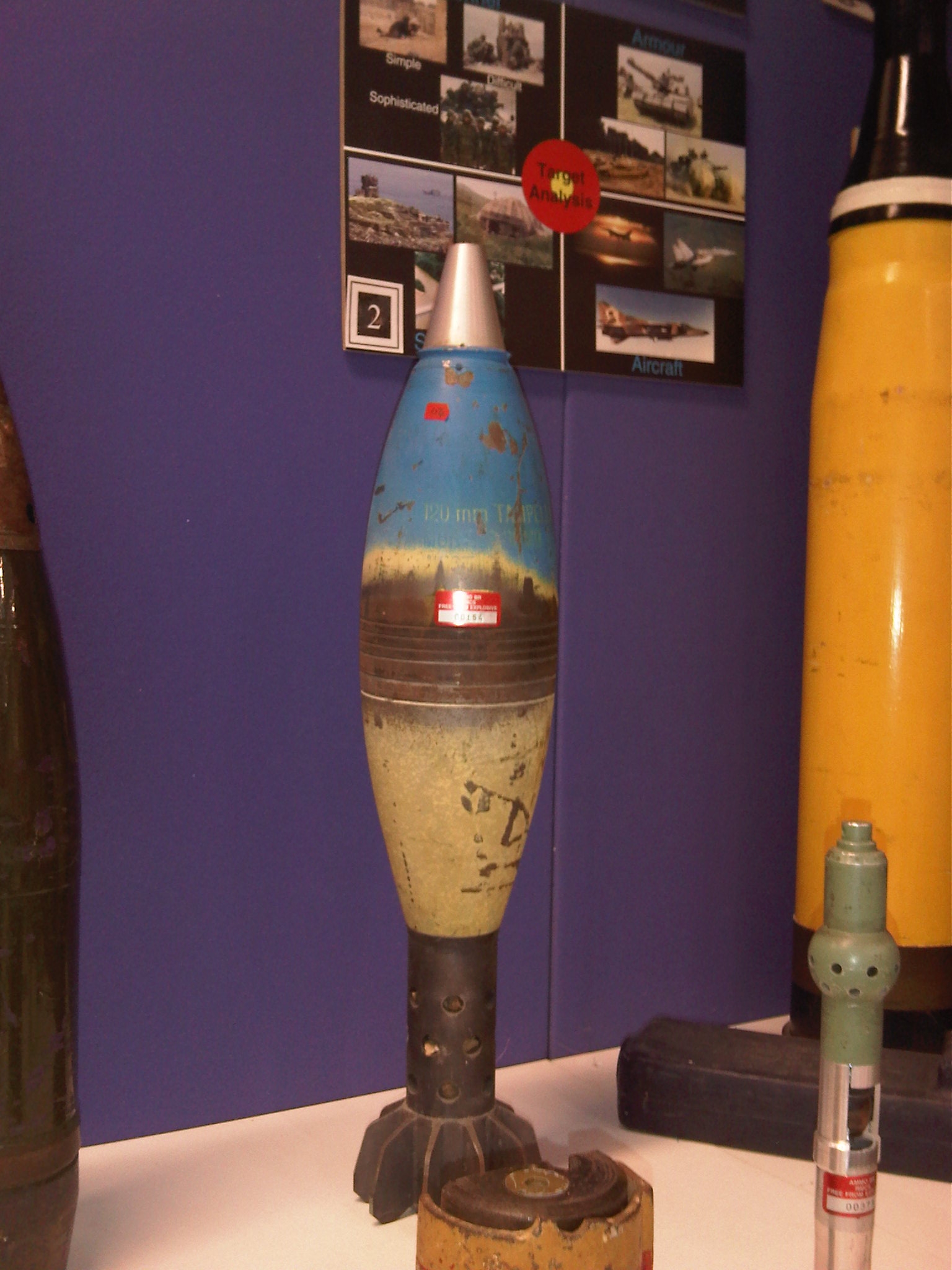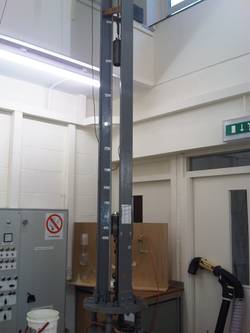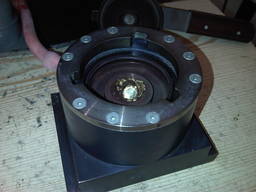Insensitive Munitions
Interview with
Chris - The field of munitions, in other words, weaponry like shells, mortars, torpedoes, and so on; in this particular domain - safety is crucial. If you're handling something that's highly explosive, the last thing you want is for it to go off in your own hands or the hands of those people who are transporting it for you. So this week, Meera Senthilingam has been to find out how scientists are trying to ensure that the munitions we're creating now and are being used in warfare, only go off when they're supposed to.
Meera - This week, I've come along to the Defence Academy of United Kingdom, located in Shrivenham in Swindon, to find out about how the munitions used today in warfare are made as safe as possible and basically, made sure that they won't go off when they shouldn't. With me is Jacky Akhavan, head of the Centre for Defence Chemistry at Cranfield University. We've got a range of mortars in front of us , how do these work?
, how do these work?
Jackie - You have, at the very bottom, a propellant. Before that, you have to ignite the propellant, so you would have an augmenting charge and then that would send the mortar up. When the mortar hits its target, the top of it will be squashed and then a pin will go through your explosive which then will send a shockwave into your main charge which does all the damage.
Meera - Traditionally, how do these types of munitions work? So, what explosives do they contain?
Jackie - Okay. Well, if you just go into the top bit, which is your fusing system, you would have a prime explosive in there which, generally speaking, would contain lead azide which is very sensitive. And then your main charge will be a combination of TNT, tri-nitrotoluene, with RDX. RDX stands for Research Development-X. It is an explosive. It's proper name is cyclotrimethylene-trinitramine.
Meera - And these materials aren't really in use as much anymore. So, why aren't they around? What were the flaws with these original designs?
Jackie - We do still use TNT and RDX, but we're trying to move away from TNT. And the reason is that first of all when you fill a munition with TNT, it shrinks when it cools down. You heat TNT up, it melts at 81 degrees centigrade and then you put in your other explosive, and then you cool it down, but you have to be very careful of the shrinkage. And also, over time, it tends to move around. So, it often comes out of the fusing system where you screw it in, you see these yellow crystals. And by moving around, you can sensitize the actual explosive. You might leave cracks and voids in the explosive, and also, around the top where it's coming out, it's quite sensitive.
Meera - So now, one way your team here are trying to get around some of these problems is by designing insensitive munitions?
Jackie - Yes, that's right. Insensitive munitions is a term to describe munition that in an accident, it won't detonate. The first thing is, we've got to take the TNT out. We have RDX, which looks like sugar, so we need to hold it in something else, but not TNT. The most common thing now is using a plastic, a polymer, and these new ones are called polymer bonded explosives. But polymers are inert whereas TNT is energetic, so we can't put too much in. So we tend to put about 95% of our high explosive with a small amount of polymer. It's like baking a cake where the polymer is your egg and the rest of the dry ingredients like the flour and sugar, is your explosive. When you mix it as we do, and then you put it into the oven, and like baking a cake, the actual composition goes solid. But it does form a very brittle type material. So, what we tend to do is add one more ingredient, like an oil, called a plasticizer, and that just gives ductility to the polymer. So if you drop it and it did crack, it wouldn't go off.
Meera - Having put all these materials together to make an insensitive munition, how do you go about making sure that this thing won't detonate under the wrong circumstances?
Jackie - What we tend to do is to do some preliminary tests, small scale powder tests. This is when we manufacture a very small quantity, then go and drop a weight on it, hit it with a hammer, or heat it up. There are standard tests we'll actually do.
Meera - And you're now going to take me along to your testing hall to see how some of these munitions are tested.
Jackie - Yes. We're going to go to the test house next...
Jackie - ...We're now in our test house and here, we have James Padfield who's a research fellow at the university and he's going to explain everything about the testing here.
 James - Hi, Meera. We have several tests here, I'll run you through a few of them. We have the Rotter test machine that measures a material's sensitiveness to impact when it gets dropped or something hits it. We have a friction test, an electric spark test, and we also have tests that measure the effect of heating and spark from a flame. We're looking for a very benign reaction, a sort of partial burn perhaps rather than a full explosion from an insensitive munition.
James - Hi, Meera. We have several tests here, I'll run you through a few of them. We have the Rotter test machine that measures a material's sensitiveness to impact when it gets dropped or something hits it. We have a friction test, an electric spark test, and we also have tests that measure the effect of heating and spark from a flame. We're looking for a very benign reaction, a sort of partial burn perhaps rather than a full explosion from an insensitive munition.
Meera - In front of us now, we have the Rotter test which tests to see how impact will affect a munition. There's a large tower, about 4 meters in height in front of me. What are the various components of this experiment, James?
James - We put a small sample of the explosive into the chamber at the bottom of the test and there's a 5-kilogram weight that we winch up the tower to a pre-determined height, and we drop the weight on the explosive.
Meera - Now, there's a small cap here that you would actually put the explosive into. The cap has a diameter of less than a centimetre?
James - About that, yes and the sample size, we use around about 30 milligrams. So yes, a very small amount.
Meera - What explosive are we going to test now?
James - This is going to be a sample of RDX.
Meera - What height are you going to drop the weight from?
James - I'm going to drop it from around about a metre and a half. Okay, so I've loaded sample into the brass cap.
Meera - Okay, so your just putting that at the bottom of the tower from which the weight will be dropped. So, the weight is being lifted up to a height of 150 centimetres. Okay. Let's go.
James - So now, we examined the sound bolt.
Meera - There's smoke coming out.
James - Yes, there's smoke and you can see the brass cap is being shattered by the RDX going off when the weight hits it.
RDX going off when the weight hits it.
Meera - So, this was a definite explosion then?
James - Yes.
Meera - So that was a height of 150 centimetres. And so, how this works is the higher the height at which it doesn't go off, the better?
James - Yes, that's right.
Meera - And now, coming back to you, Jackie. Having done these various experiments on a small scale, I imagine you must have to test these using much greater quantities in order to see if they're usable in actual munitions?
Jackie - Yes. I mean, once it passes all our tests, and it will now go into an actual warhead, they're made into a munition. The whole munition, plus the packaging, plus the container will then need to be tested on a large scale, and this then will be taken to maybe Salisbury Plain or somewhere where this can be done. A few tests might involve dropping it from a height, maybe impact via a fragment, heating it up, put it on a bonfire. The response of these tests must be burning, not detonation.
Meera - Are these insensitive munitions in use now then?
Jackie - There aren't that many actually in use. Stormshadow is certainly one that's actually been classed as an insensitive munition. In the future, yes. Definitely all of them will be classed as insensitive. No new munitions will be allowed to be used particularly for the MOD, unless they are insensitive.
- Previous Shock Physics
- Next The Ecology of Insurgency









Comments
Add a comment